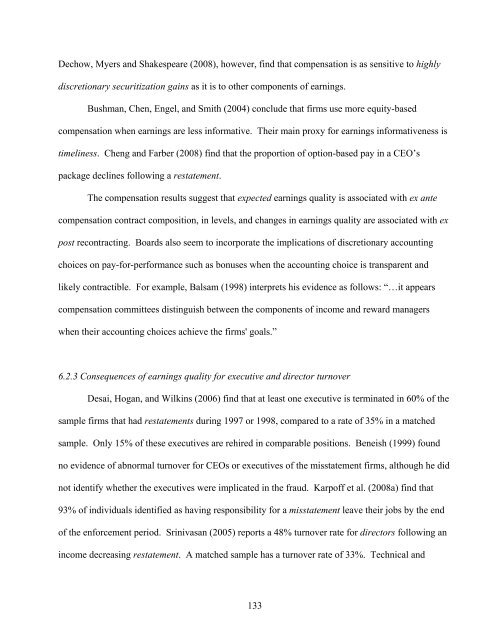Understanding earnings quality - MIT Sloan School of Management
Understanding earnings quality - MIT Sloan School of Management
Understanding earnings quality - MIT Sloan School of Management
Create successful ePaper yourself
Turn your PDF publications into a flip-book with our unique Google optimized e-Paper software.
Dechow, Myers and Shakespeare (2008), however, find that compensation is as sensitive to highly<br />
discretionary securitization gains as it is to other components <strong>of</strong> <strong>earnings</strong>.<br />
Bushman, Chen, Engel, and Smith (2004) conclude that firms use more equity-based<br />
compensation when <strong>earnings</strong> are less informative. Their main proxy for <strong>earnings</strong> informativeness is<br />
timeliness. Cheng and Farber (2008) find that the proportion <strong>of</strong> option-based pay in a CEO’s<br />
package declines following a restatement.<br />
The compensation results suggest that expected <strong>earnings</strong> <strong>quality</strong> is associated with ex ante<br />
compensation contract composition, in levels, and changes in <strong>earnings</strong> <strong>quality</strong> are associated with ex<br />
post recontracting. Boards also seem to incorporate the implications <strong>of</strong> discretionary accounting<br />
choices on pay-for-performance such as bonuses when the accounting choice is transparent and<br />
likely contractible. For example, Balsam (1998) interprets his evidence as follows: “…it appears<br />
compensation committees distinguish between the components <strong>of</strong> income and reward managers<br />
when their accounting choices achieve the firms' goals.”<br />
6.2.3 Consequences <strong>of</strong> <strong>earnings</strong> <strong>quality</strong> for executive and director turnover<br />
Desai, Hogan, and Wilkins (2006) find that at least one executive is terminated in 60% <strong>of</strong> the<br />
sample firms that had restatements during 1997 or 1998, compared to a rate <strong>of</strong> 35% in a matched<br />
sample. Only 15% <strong>of</strong> these executives are rehired in comparable positions. Beneish (1999) found<br />
no evidence <strong>of</strong> abnormal turnover for CEOs or executives <strong>of</strong> the misstatement firms, although he did<br />
not identify whether the executives were implicated in the fraud. Karp<strong>of</strong>f et al. (2008a) find that<br />
93% <strong>of</strong> individuals identified as having responsibility for a misstatement leave their jobs by the end<br />
<strong>of</strong> the enforcement period. Srinivasan (2005) reports a 48% turnover rate for directors following an<br />
income decreasing restatement. A matched sample has a turnover rate <strong>of</strong> 33%. Technical and<br />
133
















